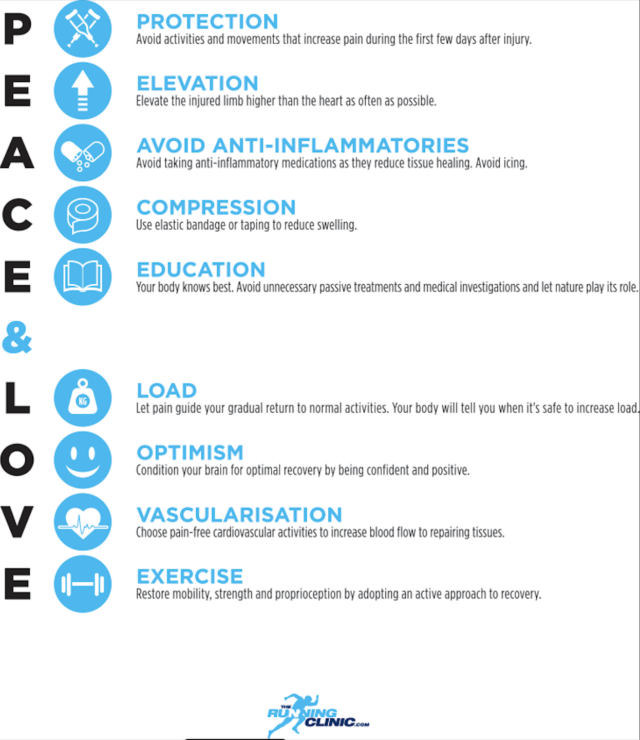In these challenging times of lockdown and COVID-19 it is vital that we look after our physical health and prevent unnecessary visits to healthcare providers such as your GP or Local Minor injuries/ A&E.
Even after life gets back to a ‘new normal’ it is no bad thing to educate yourself on the management of acute soft tissue. Check out the advice below.
The first rule of injury management (and medical management) is DO NO HARM! Don’t attempt any activity that makes the injury worse…. From there in the first 48-72 hours be guided by PEACE
Protect
You may need to Unload or restrict movement for 1 to 3 days to minimise bleeding, and reduce risk of aggravating the injury. However, complete rest should be avoided if possible as this can compromise tissue strength and quality. Your pain levels are a good guide for when you can increase load on the affected area
Elevate
Elevate the limb higher than the heart to promote interstitial fluid flow out of tissue. E.g. This may involve lying with the legs propped on pillows
Avoid anti-inflammatory modalities
Despite widespread use for acute injury, Anti-inflammatory medications may potentially be detrimental for long-term tissue healing. The inflammatory phase of healing contributes to optimal soft tissue regeneration, and inhibiting this is not recommended as it may lead to impaired healing.
Compress
Compression using tape/ compression garments (Skins etc) may help to limit intra-articular (joint) oedema and tissue hemorrhage.
Educate
Ask your physiotherapist regarding realistic recovery timeframes, prognosis and what you can do to help yourself. Don’t be afraid to ask questions. We want all patients to know the following after a consultation
1. What’s causing the pain/ injury
2. Why you have the pain
3. What we are going to do about it.
After the initial few days, we then move from PEACE to LOVE.
Load
A more active approach is now advocated for most soft tissue injuries, with movement now encouraged early and appropriate exercise selection. ‘Optimal loading’ without exacerbating pain promotes repair, remodeling and building tissue tolerance and capacity of tendons, muscles and ligaments
Optimism
The brain plays a key role in rehabilitation. Psychological factors such as catastrophisation, depression and fear can represent barriers to recovery. Pessimistic patient expectations are also associated with suboptimal outcomes and worse prognosis. While staying realistic, we encourage our clients to remain optimistic to enhance the likelihood of an optimal recovery.
Vascularisation
Pain-free cardiovascular activity should be started a few days after injury to boost motivation and increase blood flow to the injured structures. Early mobilisation and aerobic exercise improve function, work status and reduce the need for pain medications.
Exercise
Tailored Exercises will help to restore mobility, strength and proprioception early after injury. Pain should be avoided to ensure optimal repair during the subacute phase of recovery, and should be used as a guide for progressing exercises to greater levels of difficulty.
Reference
This information has been adapted for patient use from a Blog post by JF Esculier and Blaise Dubois from BJSM.

